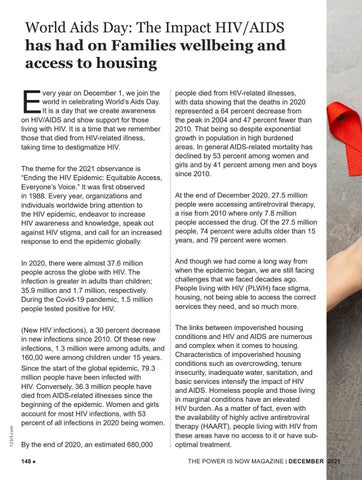World Aids Day: The Impact HIV/AIDS has had on Families wellbeing and access to housing
E
very year on December 1, we join the world in celebrating World’s Aids Day. It is a day that we create awareness on HIV/AIDS and show support for those living with HIV. It is a time that we remember those that died from HIV-related illness, taking time to destigmatize HIV.
123rf.com
The theme for the 2021 observance is “Ending the HIV Epidemic: Equitable Access, Everyone’s Voice.” It was first observed in 1988. Every year, organizations and individuals worldwide bring attention to the HIV epidemic, endeavor to increase HIV awareness and knowledge, speak out against HIV stigma, and call for an increased response to end the epidemic globally.
people died from HIV-related illnesses, with data showing that the deaths in 2020 represented a 64 percent decrease from the peak in 2004 and 47 percent fewer than 2010. That being so despite exponential growth in population in high burdened areas. In general AIDS-related mortality has declined by 53 percent among women and girls and by 41 percent among men and boys since 2010. At the end of December 2020, 27.5 million people were accessing antiretroviral therapy, a rise from 2010 where only 7.8 million people accessed the drug. Of the 27.5 million people, 74 percent were adults older than 15 years, and 79 percent were women.
In 2020, there were almost 37.6 million people across the globe with HIV. The infection is greater in adults than children; 35.9 million and 1.7 million, respectively. During the Covid-19 pandemic, 1.5 million people tested positive for HIV.
And though we had come a long way from when the epidemic began, we are still facing challenges that we faced decades ago. People living with HIV (PLWH) face stigma, housing, not being able to access the correct services they need, and so much more.
(New HIV infections), a 30 percent decrease in new infections since 2010. Of these new infections, 1.3 million were among adults, and 160,00 were among children under 15 years.
The links between impoverished housing conditions and HIV and AIDS are numerous and complex when it comes to housing. Characteristics of impoverished housing conditions such as overcrowding, tenure insecurity, inadequate water, sanitation, and basic services intensify the impact of HIV and AIDS. Homeless people and those living in marginal conditions have an elevated HIV burden. As a matter of fact, even with the availability of highly active antiretroviral therapy (HAART), people living with HIV from these areas have no access to it or have suboptimal treatment.
Since the start of the global epidemic, 79.3 million people have been infected with HIV. Conversely, 36.3 million people have died from AIDS-related illnesses since the beginning of the epidemic. Women and girls account for most HIV infections, with 53 percent of all infections in 2020 being women. By the end of 2020, an estimated 680,000 148 l
THE POWER IS NOW MAGAZINE | DECEMBER 2021
